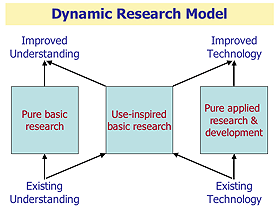|
|
It's a much more dynamic view when you look at this two-dimensional world. And then you have the pure applied research leading to development. When you look at this dynamically, if you were doing pure applied research in Edisonian mode, you were fundamentally using existing technologies. You're trying different types of approaches to the problem, different types of technology, but you're fundamentally looking at existing technology.
When you're doing pure basic research that is curiosity-driven, your starting point is your current understanding. What's the basic understanding that you have at this time? That is, you start from the existing understanding, but you also start from what is the base technology, the developments that you have at that time to be able to address particular questions. The second piece of it—the output from pure research—is an improved understanding because you started with certain knowledge, you improved, and you increased that knowledge, so you have improved understanding of the nature of the world in which you exist. Use-inspired research takes this and can also improve the understanding.
I think a perfect example of that is right here in Seattle with Lee Hood, who founded the Institute of Systems Biology here. He is the guy who came up with the technology for the DNA sequencer. So almost all of the knowledge we've gotten in molecular genetics in the last 15 years was driven by a set of technology that was developed to say, “How am I going to go after and try to look at these base pairs in a DNA molecule as quickly and as rapidly as possible so I can ask fundamental questions?” Also too, when you're doing this, it will lead to improved technologies because with that understanding, you can change where you started with the existing technology. So use-inspired can do both.
>
01 02 03 04 05 06 07 08 09 10 11 12 13 14 15 16 17 18 19
|
|

|
